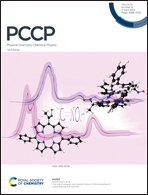Nitrogen and sulfur co-doped Ti3C2Tx MXenes for high-rate lithium-ion batteries†
Abstract
The electrification of heavy-duty transport and aviation urgently requires new strategies to develop high-rate lithium-ion batteries (LIBs) whose performance fundamentally relies on electrode materials. However, commercially available graphite anodes still suffer from slow kinetics of lithium-ion diffusion and severe safety concerns of lithium plating when achieving the high-rate use goal. Herein, taking Ti3C2Tx as an example, it is demonstrated that N and S co-doping in Ti3C2Tx results in a high-rate MXene anode for LIBs. Nitrogen doping not only flattens the MXene layers and expands the interlayer spacing but also increases the Ti valence state change ability. As evidenced by density functional theory calculations, the diffusion barriers of S-containing Ti3C2Tx MXenes are lower than those of the S-free counterpart, suggesting that S plays an essential role in achieving high-rate performance. Therefore, the N and S co-doped Ti3C2Tx anode in LIBs exhibited excellent performance with a reversible capacity of 113.8 mA h g−1 at a rate of 3C and ∼89% capacity retention after 1000 charge/discharge cycles. The high capacity is attributed to the change in the oxidation states of both Ti and O elements, and the tiny volume change within ∼0.6% upon the stable charging/discharging process accounts for the good capacity retention. When paired up with a LiFe0.5Mn0.5PO4 cathode, the full cell delivers a reversible capacity of 134 mA h g−1 after 1000 cycles at a high rate of 1C. The demonstration of N and S co-doped Ti3C2Tx MXenes in this work may offer a feasible approach for high-rate intercalation anode materials.



 Please wait while we load your content...
Please wait while we load your content...